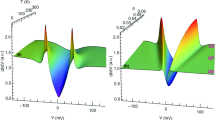Abstract
Improved tunneling spectroscopy with point contact junction of [BSCCO (2212) / SiOx] / Au-tip provided us information of the quasi-particle that mediates the high Tc Cooper pairing. Fine structure in the tunneling conductance derivative spectrum d2I/dV2 — V reflects the quasi particle coupling spectrum function α2(ω)F(gw), and really significant peaks have been observed ranging to 0.2eV. Their peak energy level eVi could be systematically assigned by eVi − Δ = nɛ0 + hωi(ph) with n=0, 1, 2, Here hωi, means each phonon mode energy, and the characteristic energy ɛ0 = 72 meV was found to correspond to the breathing mode which is essentially Cu-O bond stretching mode. This means that these characteristic phonons play a significant role on the high Tc superconductivity. Similar peak series had been also observed in the infra-red (IR) optical reflection spectrum, R(ε) by Capizzi et al. The Cooper pairing characteristics are discussed from the comparison between both spectra of the tunneling and the IR.
Similar content being viewed by others
References
R. Aoki, H.Murakami and T.Kita,Physica C 225, 1 (1994).
R. Aoki, H.Murakami, T.Kita, M.Shirai, Y.Nishio, V.M.Svistunov, A.I. Dyachenko and D.N., Afanassyev,Physica B 219, 172 (1996).
R.Aoki, H.Murakami, et al., to appear in it “Spectroscopic Studies of Superconductors” (SPIE Bellingham U.S.A 1996).
J.R.Kirtley,Intl. J. Mod. Phys. B4, 201 (1990).
R.Aoki and H.Murakami, to appear in “Studies of High Temp. Superconductors”ed. by A.V.Narlikar vol.20 (Nova Sci. Pub. NewYork).
M.Capizzi, S.Lupi, P.Calvani et al.,Physica C 235–240, 273 (1994).
Z.V.Popovic et al.,Solid State Commun. 66, 965 (1988)
Q.Huang et al.,Nature 347, 369 (1990), and T.Ekino and J.Akimitsu,J. J. Phys. ser7, 260 (1992)
N.Miyakawa et al.,J. Phys. Soc. Jpn. 62, 2445 (1993), D.Shirda et al,Phys. Rev B5-1, 6451 (1995)
S.I.Vedeneev et al.,Physica. C 235–240, 1851 (1994), R.S.Gonnelli et al.,ibid 1861, B.A.Aminov et al, ibid1863, R.Aoki et al.,ibid 1891 and N.Tsuda et al.,ibid 1889.
P.Calvani et al.,Phys. Rev. B 53 2756 (1996)
J.Lorenzana,J. Low. Temp. Phys. 99, 299 (1995).
T.Egami, et al.,Physica B 219–22 (1996).
P.B.Littlewood et al.,Phys. Rev. Lett. 63, 2602 (1989).
D.J.Scalapino,Physics Reports 250, 329 (1995).
T.Yokota, et al.,Phys. Rev. B 53, No.22 (1996).
K.Nasu,Phys. Rev. B 37, 5075 (1988).
A.Alexandrav and J.Ranninger,Phys. Rev. B 23, 1796 (1981).




